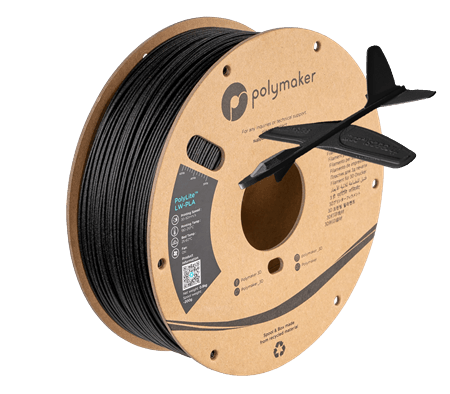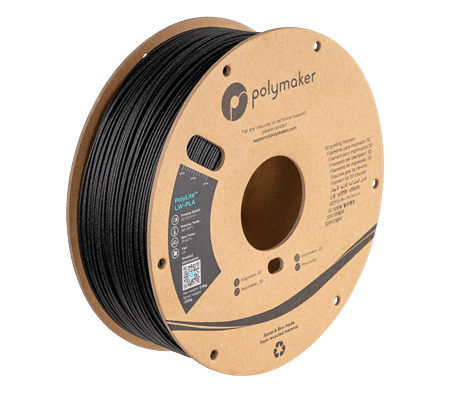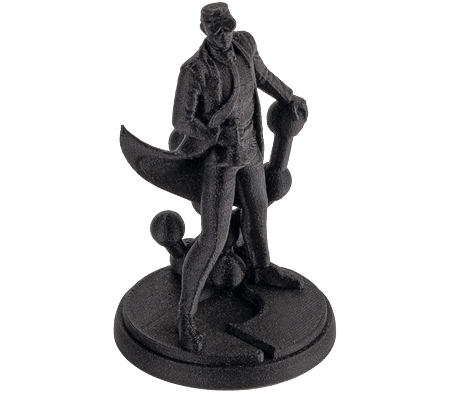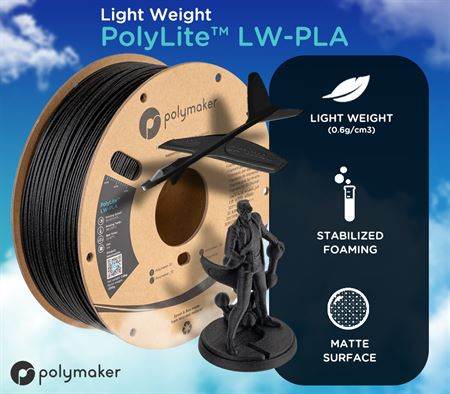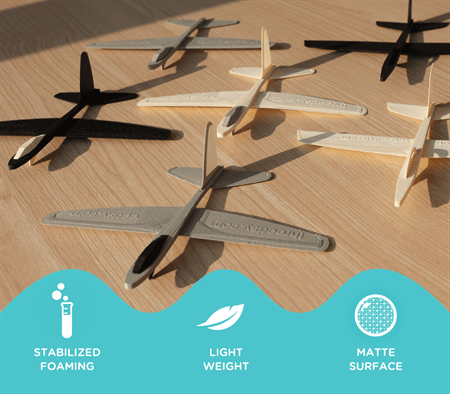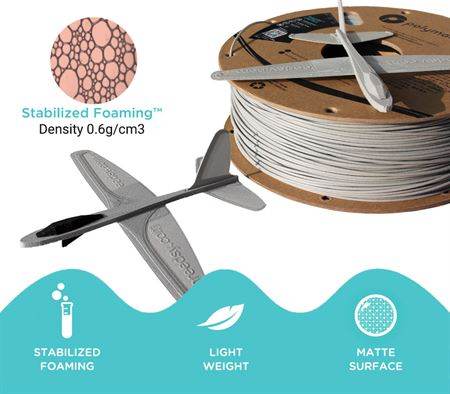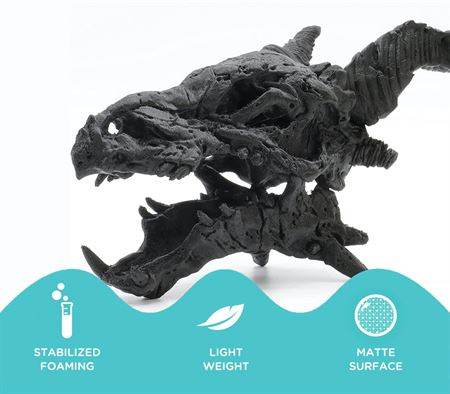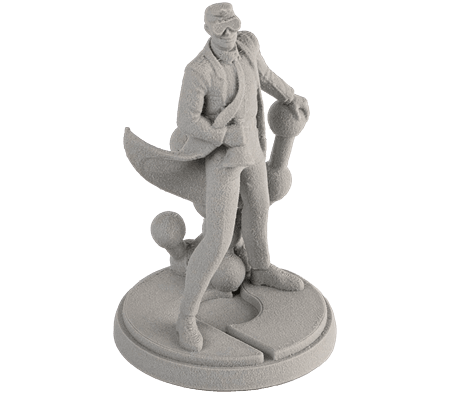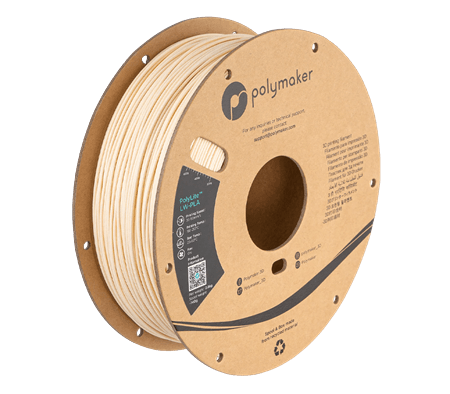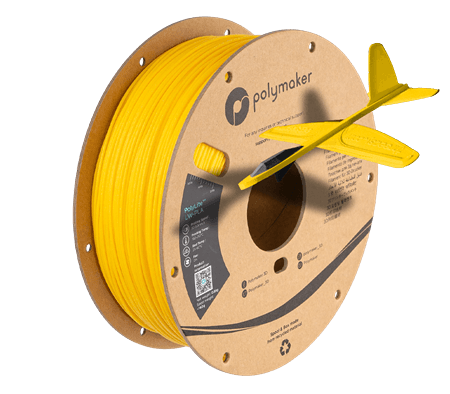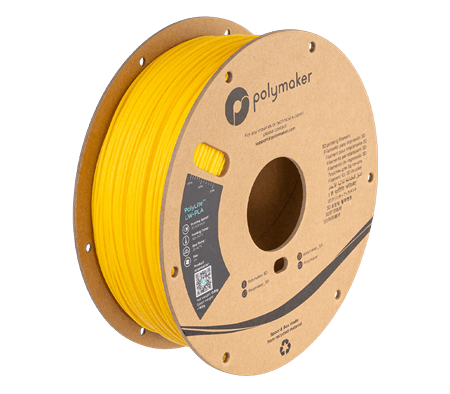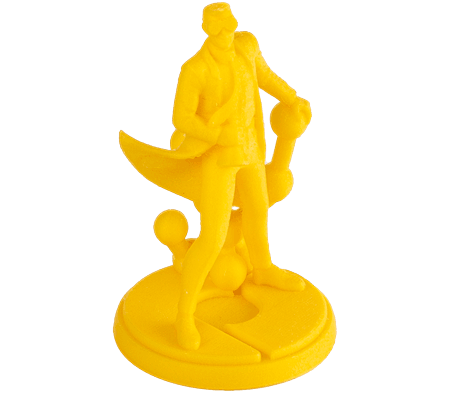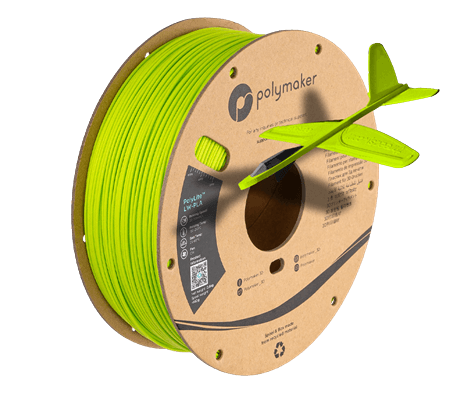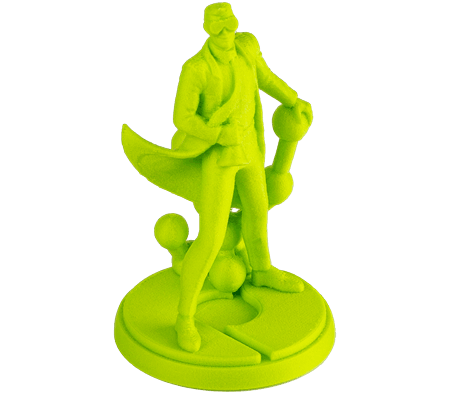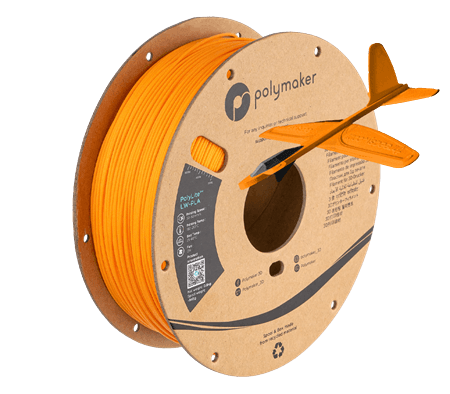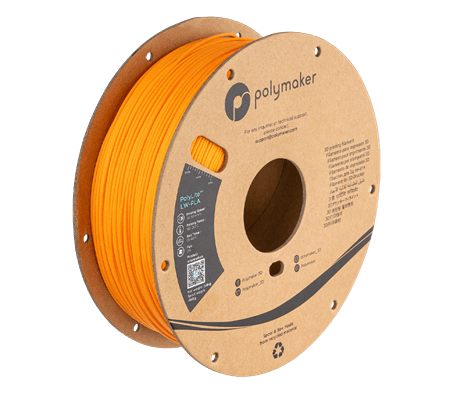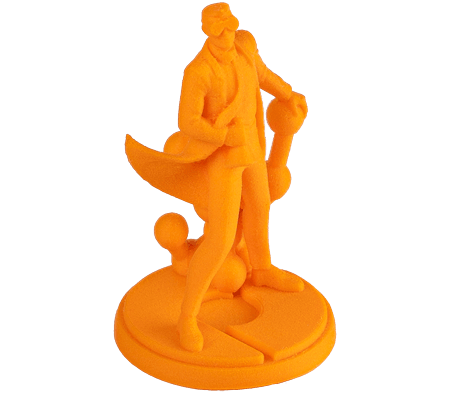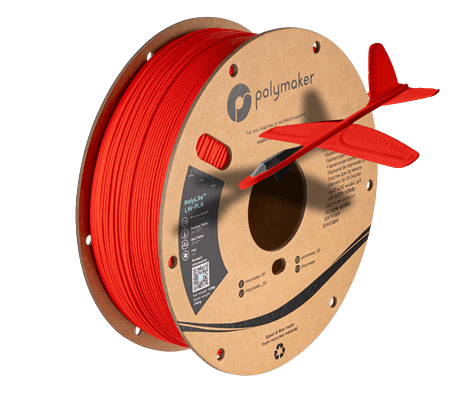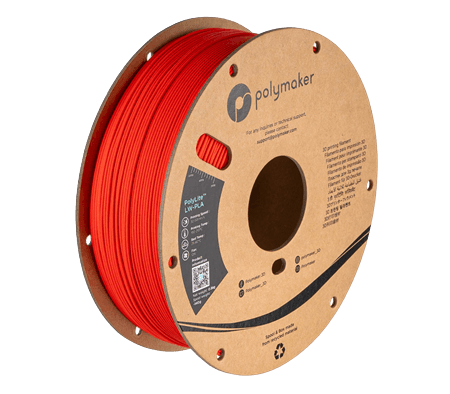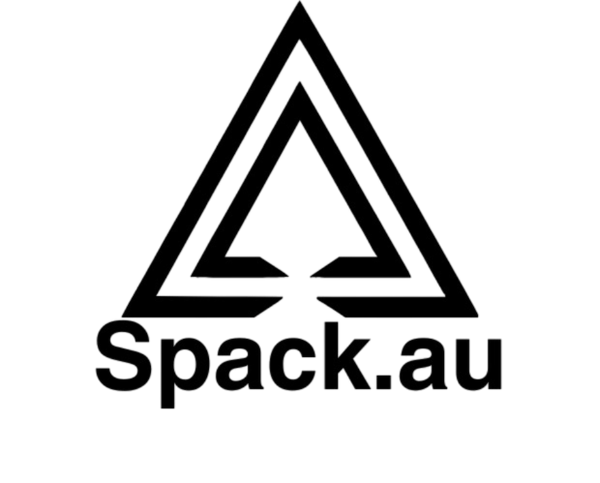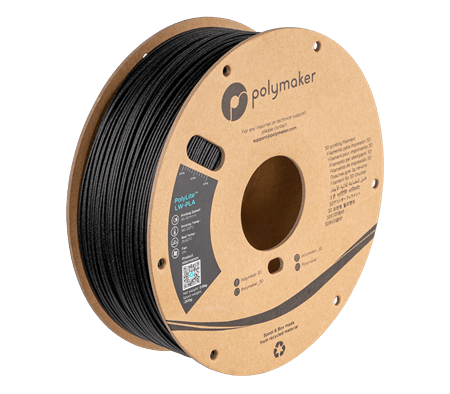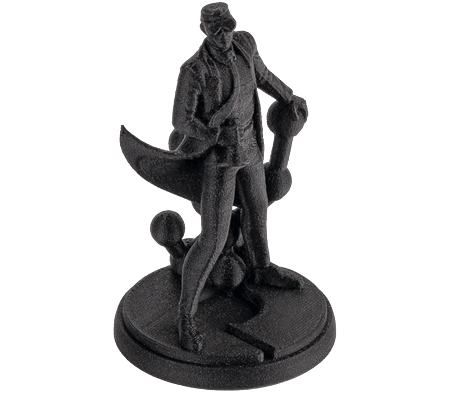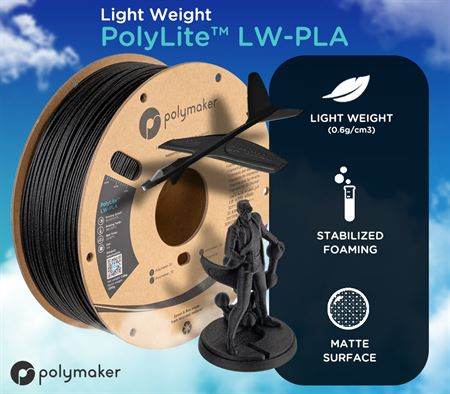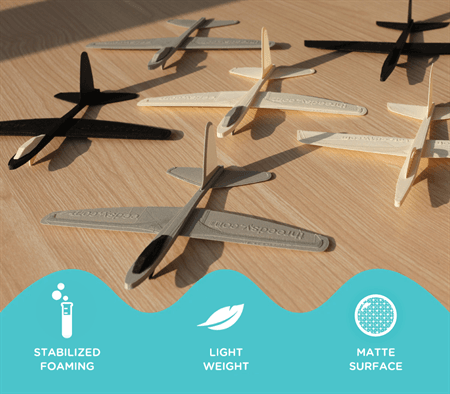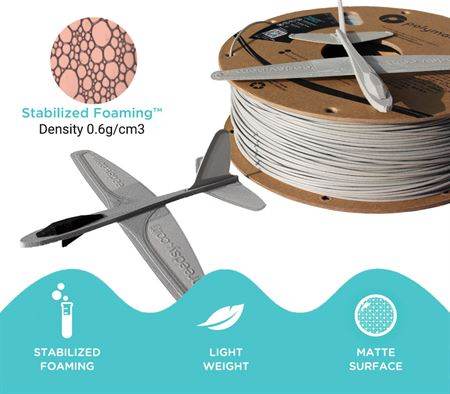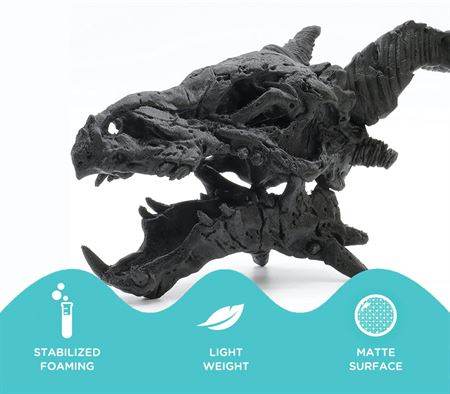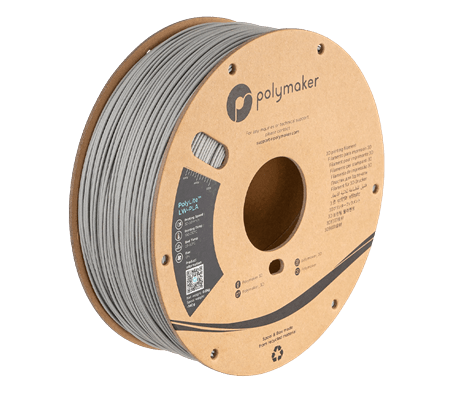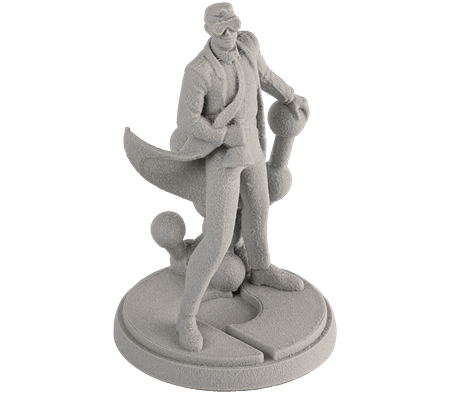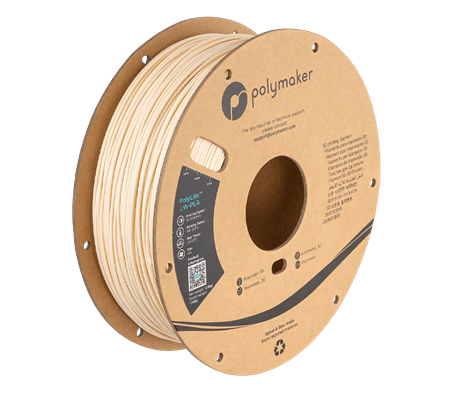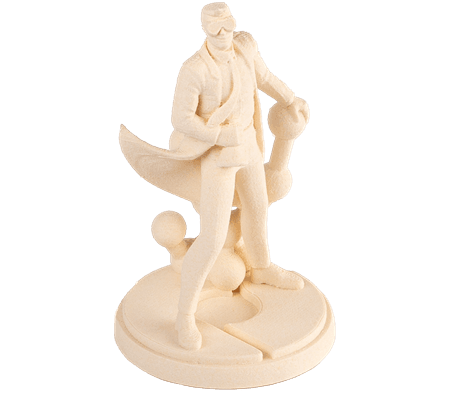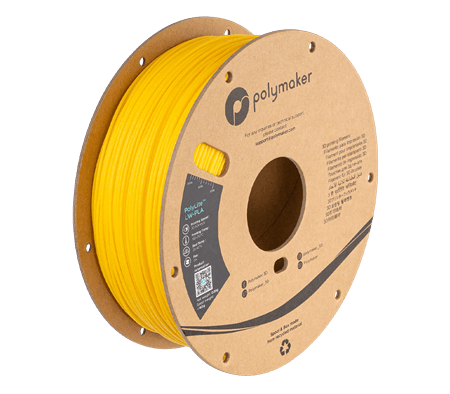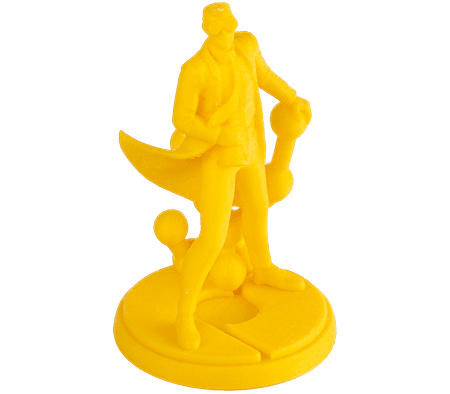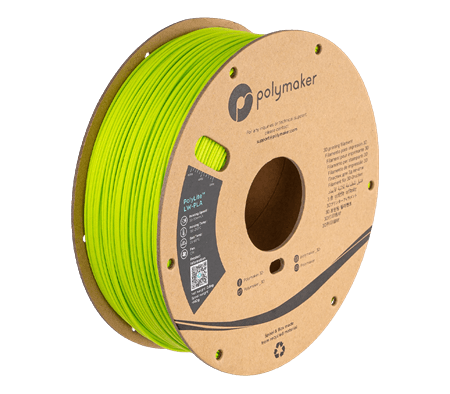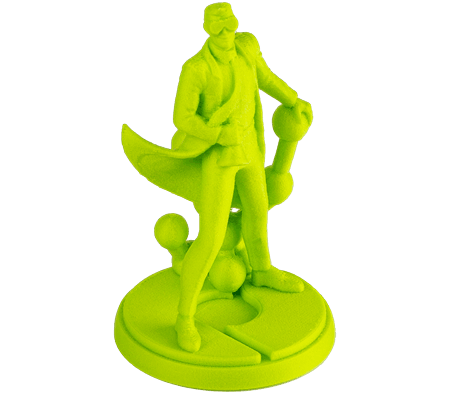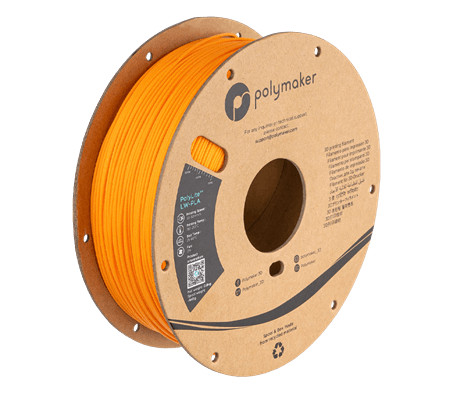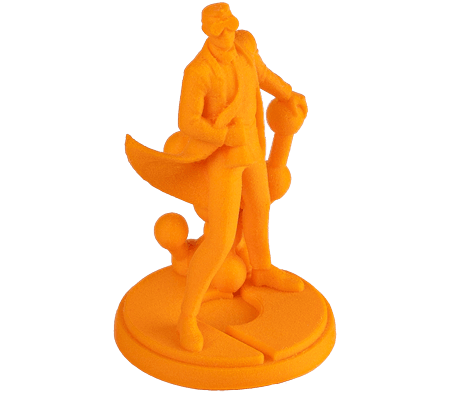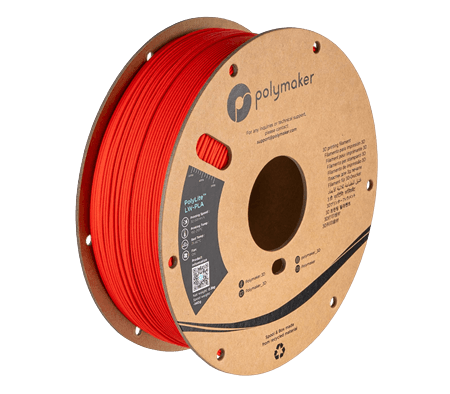Polymaker
Polymaker PolyLite LW-PLA 800g 1.75mm Filament
Polymaker PolyLite LW-PLA 800g 1.75mm Filament
Out of stock
Couldn't load pickup availability
Light-weight PLA with matte surface finish and Stabilised Foaming™ technology.
- High quality prefoamed Polymaker LW-PLA.
- Stabilised foaming produces light weight models (0.6g/cm3).
- Grain matte surface finish.
- Easy-to-print.
- Consistent colour and tolerance (1.75mm diameter +/- 0.03mm)

PolyLite™ LW-PLA is a special foamed PLA filament designed to print with similar settings as regular PLA but with half the weight (0.6g/cm3). Its low density makes PolyLite™ LW-PLA an excellent choice for printing light weight parts including fuselages, wing parts and other lightweight components for RC planes. Due to the foaming technology, this LW-PLA also prints with a very matte surface finish which hides the layers for a wide range of aesthetic applications.
Pre-foamed PLA filaments can be quite stiff and more brittle than regular PLA so it is recommended to take extra care and make sure your filament guide system is smooth and with minimal bends. When not in use, please use tape to secure the filament tip to the spool the rather than attempting to bend the filament through the spool guide hole. Do not rewind this filament onto another spool.
Features
-
Low Density with Stable Foaming - PolyLite™ LW-PLA is a lightweight PLA filament formulated with Polymaker's Stabilised Foaming™ technology to produce pre-foamed filament whose foam structure can survive the printing process and be inherited by the printed parts. PolyLite™ LW-PLA enables 3D printing of lightweight models with a consistent low density (0.6g/cm3), even when printing at low temperatures (~190˚C).
Unlike other LW-PLA filaments that actively foam during the printing process depending on temperature, PolyLite™ LW-PLA's stabilised foaming technology offers significant advantages. Compensating for the varying foaming rate that occurs with competitor LW-PLA usually requires significant tuning, but with Polymakers stabilised foaming PLA the density and extrusion width are consistent regardless of temperature. This not only reduces the difficulty in tuning Polymakers LW-PLA, but also gives more freedom to choose the right nozzle temperature for print quality without worrying about how it changes the material density. -
Matte Finish - The Stabilised Foaming™ technology in PolyLite™ LW-PLA delivers an incredible matte surface finish which makes it a unique material choice for aesthetic applications such as architectural models, figurines, gaming dioramas, decoration or lifestyle parts.
-
Compatibility / Jam-Free™ - PolyLite™ LW-PLA is compatible with a wide range of 3D printers and is manufactured with Polymakers Jam-Free™ technology which leads to excellent printing quality with zero risk of nozzle jams caused by heat creep [1]. PolyLite™ LW-PLA works well with many common printing surfaces and a heated bed isn't strictly required but may be recommended with some build plate surfaces or geometries for better results (up to 60°C).
-
Uncompromised Quality - PolyLite™ LW-PLA filament is a PLA-blend made with the highest quality ingredients including Ingeo® from Natureworks. Natureworks is a world-leading biopolymers supplier based in the USA with a portfolio of high quality raw PLA materials produced from rapidly renewable plant resources. Combining Polymakers innovative R&D technologies, compounding and extrusion systems with Natureworks Ingeo® resins produces a reliable 3D printing filament to print beautiful and accurate models
[1] Heat creep is the the process of heat spreading irregularly throughout the hot end, one common example is with all metal hot end designs. Once heat creeps towards the cold end, the PLA filament softens prematurely in the cold end and expands resulting in a jam. Polymakers Jam-Free™ technology increases the heat resistance of the filament itself (not the printed part) to 100˚C which prevents the filament from prematurely softening in the cold end and can still melt rapidly once entering the heating zone.

Printing Settings
| Nozzle Temperature | 190°C - 210°C |
|---|---|
| Build Plate Temperature | 25°C - 60°C |
| Build Surface Material | Works well with most build surfaces i.e Glass, Blue Tape, BuildTak® etc |
| Build Surface Treatment | Typically none required. Some printers may benefit from PVA glue or Magigoo Original applied to the build surface. |
| Cooling Fan | ON |
| Printing Speed | 30 mm/s - 50 mm/s |
| Retraction | The ideal retraction settings vary from printer to printer. Direct Drive: Retraction distance of 3mm with retraction speed of 40mm/s Bowden: Retraction distance of 6mm with retraction speed of 40-60mm/s |
| Recommended Support Material | Single Extrusion: Self Support Dual Extrusion: PolyDissolve™ S1 or PolySupport™ |
The above are printing recommendations based on 0.4 mm nozzle. Please note ideal printing conditions may vary depending on your 3D printer setup. For high speed 3D printers, make sure to increase your extrusion temperature in order to use higher printing speeds.
Pre-foamed PLA filaments can be quite stiff and more brittle than regular PLA so it is recommended to take extra care and make sure your filament guide system is smooth and with minimal bends to minimise drag and deflection. When not in use, please use tape to secure the filament tip to the spool the rather than attempting to bend the filament through the spool guide hole. Do not rewind this filament onto another spool.
Specific Printing Tips for PolyLite™ LW-PLA
- Pre-foamed PolyLite™ LW-PLA doesn't significant adjustment to flow rate. Start with a flow rate similar to what you use for regular PLA and make small adjustments based on the result.
- Like other foam PLA filaments, PolyLite™ LW-PLA can tend to have more stringing than regular PLA which is relatively easy to remove with tweezers or a scalpel. To reduce stringing during printing we recommend to adjust the retraction settings, lower the extrusion temperature and increase the print head travel speed. For some RC applications and geometries, printing with spiralise vase mode can result in better quality compared to simply turning off infil and top layers.
For other tips printing PolyLite™ LW-PLA, contact us!
Specification
| Net Weight | 800g |
|---|---|
| Material Type | Foam PLA (Stabilised Foaming) |
| Density | Printed Model - 0.6 g/cm3 Filament on Spool - 0.8 g/cm3 |
Compatibility
PolyLite™ LW-PLA has been engineered with compatibility in mind to print excellently on a wide range of 3D printers. To get the best results always recommended to spend time tuning the settings to suit your printer and filament combination.
PolyLite™ LW-PLA is manufactured with Polymakers stabilised foaming technology which means the filament is pre-foamed with small bubbles inside the material offering a low density material which prints with a matte finish. Pre-foamed PLA filaments can be quite stiff and more brittle than regular PLA so it is recommended to take extra care and make sure your filament guide system is smooth and with minimal bends.
Of course with thousands of unique 3d printer models on the market, we can't guarantee each filament type will work with every 3D printer. Slicer experience and setting adjustment is always required to get the most out of a material. Before jumping into an ambitious project we always recommend printing some known calibration tests to build or make adjustments to the filament profile.
Technical Data
Data based on Polymaker TDS 5.3
All testing specimens were printed under the following conditions: Nozzle Temperature = 195˚C, build plate temperature = 60˚C, infil = 100%, cooling fan = ON
All specimens were conditioned at room temperature for 24h prior to testing.
THERMAL PROPERTIES
| Value | Testing Method | |
| Glass Transition | 58.7°C | DSC, 10°C/min |
| Heat Deflection Temperature |
0.45MPa - 54.2°C HDT Curve |
ISO 75 |
| Vicat Softening Temperature | 60.3°C | ISO 306, GB/T 1633 |
MECHANICAL PROPERTIES
| Value | Testing Method | |
| Youngs modulus (X-Y) |
1,688.5 ± 80.8 MPa | ISO 527, GB/T 1040 |
| Tensile strength (X-Y) |
24.4 ± 0.3 MPa | ISO 527, GB/T 1040 |
| Tensile strength (Z) |
20.8 ± 0.9 MPa | ISO 527, GB/T 1040 |
| Elongation at break (X-Y) | 8.8% ± 0.4 | ISO 527, GB/T 1040 |
| Elongation at break (Z) | 2.0% ± 0.4 | ISO 527, GB/T 1040 |
| Bending modulus (X-Y) |
1958.9 ± 72.6 MPa | ISO 178, GB/T 9341 |
| Bending strength (X-Y) |
50.2 ± 1.6 MPa | ISO 178, GB/T 9341 |
| Charpy impact strength (X-Y) |
2.4 ± 0.3 kJ/m2 | ISO 179, GB/T 1043 |
We have full MDS and technical data sheets for PolyLite™ LW-PLA and all other Polymaker products. Contact us to enquire!
The typical values presented in Polymakers data sheet are intended for reference and comparison purposes only. Due to the nature of 3D printing they should not be used for design specifications or quality control purposes.
STORAGE & DRYING
All plastics are hygroscopic meaning they absorb moisture from the air which can affect printing quality and strength of printed parts. How quickly this absorption occurs depends on the material and your environment. Polymakers PolyLite™ LW-PLA filaments are dried and packaged in a vacuum sealed bag with desiccant to ensure the best printing quality. When not in use PolyLite™ LW-PLA should be stored away from sunlight and sealed in the packaged resealable bag.
Although filaments can be dried, drying will speed up the aging process of the plastic making it more brittle over time. Preventing the filament from absorbing moisture in the first place is the best solution to keep your filament working to its maximum potential. For long term storage we highly recommend storing in a sealed container with dry desiccant that reduces the relative humidity to 10-20% RH.
In-house we manage our filaments with Polymakers PolyDryer™ which keep offers best-in-class sealing to protect filaments from absorbing moisture
If you hear popping sounds and notice that the surface quality of your print is uneven or the colour is not consistent, this is a likely indicator that the filament has absorbed too much moisture. Spools of PolyLite™ LW-PLA can be dried with Polymaker PolyDryer™ using power level 1. Alternatively if you have a convection oven that is accurate at low temperatures, users can dry filament in a preheated convection oven at 55˚C for up to 6 hours. Results may vary depending on the accuracy of your oven so please be conservative. For more information about filament drying please read our user guide.
FAQ
Q: How does PolyLite™ LW-PLA compare to other LW / Foam PLA materials?
A: There are two types of LW-PLA; active foaming and passive foaming. Active foaming means the filament foams during the printing process and the foaming rate is determined by printing settings such as extruder temperature and flow rate. LW-PLA filaments with passive foaming are manufactured with a foam structure which is maintained during the printing process, the density is not really impacted by the printer settings. Active foaming LW-PLA filament requires precise adjustments to printing settings, including temperature and flow rate, in order to account for the expansion of the material during printing. This often necessitates the use of high temperatures, around 250 degrees, to achieve lightweight prints. However, these high temperatures can also lead to defects such as stringing and blobs. While active foaming can provide more control over the density of the final print, it can be more challenging to achieve both lightweight results and high dimensional accuracy in the final product.
PolyLite™ LW-PLA is a passive foaming filament, which offers a consistent foaming rate, giving you the flexibility to select the optimal temperature for your desired part quality without having to worry about the effect on density. This allows you to achieve lightweight results even at low temperatures of around 190 degrees. Typically the lower the temperature the higher the quality of the final print.
Q: Does Jam-Free™ technology prevent all filament jamming?
A: Jam-Free™ technology is designed to prevent jamming caused by heat creep. There are many reasons why a material may jam, such as printing with the wrong extruder temperature or incorrect nozzle height; Polymaker's Jam-Free™ technology won't prevent jamming in these cases.
Q: Can PolyLite™ LW-PLA be printed at large scales without warping?
A: One of the benefits of PLA is the ability to print large parts with excellent dimensional stability; we have many customers printing large full-size printing projects in PolyLite™ LW-PLA. Please note that while PLA materials don't warp in most situations, printing with poor first layer adhesion can cause any material to warp and printing or the heated bed too hot can cause any PLA filament to crystallise rapidly, creating internal stress and warping.
Q: What support materials can I use with this product?
A: Polymaker’s PolyDissolve™ S1 or PolySupport™ filament are the recommended support filaments for PolyLite™ LW-PLA. If your 3D printer is not equipped for multi-material, self-support can be used.
Q: Should I rewind this filament if I want to use it with a different spool?
A: We strongly advise against tampering with the product by rewinding. It is not recommended to rewind any filaments, but especially not LW-PLA. See our article for full details about the risks. All Polymaker filaments are wound with tension but without strain. Rewinding completely rearranges the curvature of the winding and this strain over time can cause most plastics to catastrophically break. If for some reason your printer is locked into fitting less than standard sized spools, there may be safe printable adaptors or external mounting solutions available.
Don't know where to start? Or which filament will suit your application? We have a broad range of support options including telephone support. Contact us today!
| Filament | |
| Diameter | 1.75mm |
| Spool Weight | 800g |
LW-PLA (light weight PLA) is a a cutting-edge category of PLA filaments specifically engineered for RC planes and other applications that require a lightweight and easy to print material. The low density is achieved through the use of a foam structure, which offers a unique balance of strength and weight for 3D printing. Combined with an attractive matte surface finish, PolyLite™ LW-PLA lends itself to a wide range of applications including:
- Aerodynamic RC plane wings
- RC-plane fuselages
- Cosplay props
- Weight critical parts in research applications
- Other lightweight components.
- Architectural models.
- Homewares.
There are two types of LW-PLA; active foaming and passive foaming. Active foaming occurs during the printing process and the foaming rate is controlled by the printer settings such as temperature and flow rate. However, this process can be challenging to achieve both lightweight results and high dimensional accuracy in the final product. It often necessitates the use of high temperatures, around 250 degrees, to achieve lightweight prints, but this can also lead to defects such as stringing and blobs. Passive foaming filaments, like PolyLite™ LW-PLA are manufactured as a pre-foamed filament whose foam structure can survive the printing process and be inherited by the printed parts. This results in a consistent low density regardless of temperature, giving you the flexibility to select the optimal temperature for your desired part quality without having to worry about the effect on density. This enables lightweight 3D printing even at lower temperatures of around 190 degrees. Typically, the lower the temperature, the higher the quality of the final print, making this LW-PLA an ideal solution for those looking for a balance of light weight and high-quality prints.
Materials
Materials
PLA - This solid filament is used to make models that are a refined representation with rigid properties.
TPU - This flexible filament holds the shape of the model and can with stand being twisted and squashed to survive the field environment.
Shipping
Shipping
Free standard shipping and Express for free orders over $300 calculated at the checkout.
All items are shipped from Townsville, QLD.
Shipping World Wide - coming soon.
Care Instructions
Care Instructions
PLA
Temperature:
Keep it cool! PLA starts to soften at around 60°C (140°F), so avoid placing it near heat sources or leaving it in hot cars.
Sunlight:
Prolonged direct sunlight can cause fading and potential deformation. Try to keep it out of long sun exposures.
Cleaning:
Gently wash with warm water and a bit of mild soap using a soft cloth. No harsh scrubbing, please!
Handling:
Handle with care—avoid excessive bending or dropping it, as PLA is rigid and can crack or break.
Storage:
Store in a cool, dry place to maintain its shape and longevity.
TPU
Temperature:
TPU is built to be flexible, but still avoid extreme or prolonged heat. It’s more resilient than PLA, but unnecessary heat can still degrade it over time.
Sunlight:
Try not to leave TPU items in direct sunlight for too long, as UV rays can fade the colors and slowly affect the material quality.
Cleaning:
Just like PLA, a quick clean with warm water and mild soap works great. Use a soft cloth and don’t be too rough.
Handling:
Enjoy its flexibility! However, even though TPU can bend, continuous stretching or heavy impacts might wear it out faster.
Storage:
Keep it in a cool, dry spot away from harsh elements to maintain its flexibility and appearance.
Share
